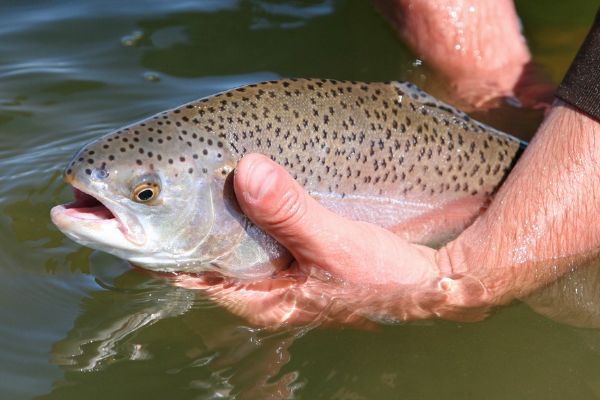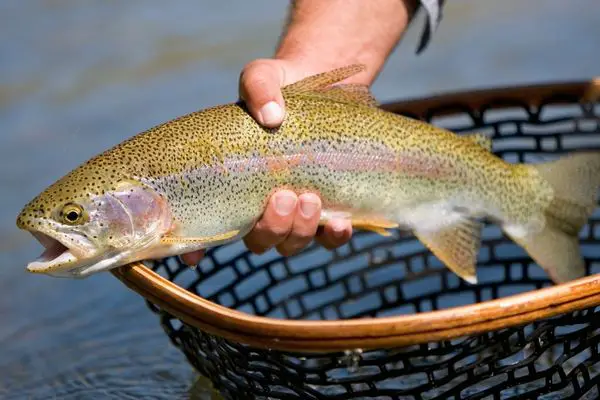Catching holdover trout in a stock pond or lake can be challenging. They have had time to acclimatize to the local conditions.
At the start of the new season, the biggest trout are often holdovers.
But, the recently stocked trout normally greatly outnumber them and are more aggressive feeders than the resident fish. They always seem to hit the bait or lure first.
The trick is to target holdover trout like they are wild fish.
In this guide, I will look at ways to catch large mature trout in fisheries dominated by hatchery fish.
Late winter into early spring fishery authorities release thousands of hatchery reared trout into hundreds of lakes and ponds across America.
Hatchery-raised trout are often small and not much of a challenge to land. At the time of stocking, the average year old trout weighs around a quarter pound, while two year old holder can be pushing two pounds. A much more respectable size.
What do holdover trout eat?
Upon release, all stocked trout behave like hatchery raised fish, their diet not yet adapted to the natural food in the lake. At times they will eat just about anything.
The usual bait of choice is artificial bait, which imitates pellets rather than insects and bait fish. One popular example is the Berkley Powerbait. Scented dough baits are one of the best performing baits when targeting stock trout.
However, stock trout which survive the previous season and have become holdover trout have long since forgotten their hatchery diets. Like the wild trout, they have become fully reliant on the lake’s food chain. This means the bulk of a holdover trout diet will be insects and small prey fish.
Naturalized trout instinctually hunt fleeing baitfish, making hard lures such as spoons, jerkbaits and spinners more effective.
Insects are also a large portion of a wild trout’s diet, so that holdover trout is more likely to go after a well presented mayfly or nymph fly compared with a ball of scented dough.
The bait fisherman can have a lot of success fishing nightcrawlers and other terrestrial insects.

How to avoid the stock trout and find holdover trout?
Recently released stock trout travel around in large schools, confused and not familiar with their new home they stick together. For hours after release, some newly planted trout stay close to the release site. At night, protected by darkness, most will move away from their release site.
To find safety they head to the relative protection of open water. Fishermen often report stocked trout schooling around quite high in the water column out in the open. Over time, as they explore, they can turn up in almost any part of the lake.
Holdover trout have learned where the food is, and if you find the food. You will find the holdovers. They have established territories and generally do not travel far from their feeding grounds.
Prime locations to find holdover trout
- Holdover trout often cruise weedlines
- around structures such as between the branches of sunken trees.
- In shallow flats, especially if the water is cold
- Near the bottom of steep drop-offs, which border onto flats.
- Near the mouth of rivers and streams
- On stocking day holdover trout can often be found much deeper in the water column compared with recent releases.
How to catch holdover trout?
The easiest place to catch trout is where they feed. Fish drop-offs, holes, weed beds, and river mouths. These places are prime feeding grounds for holdover and wild trout.
During the warmer months, there is an abundance of insect life. So it is also well worthwhile checking lakeshore vegetation for terrestrial insects. These insects lose their footing or get blown into the cool water below. Resident trout know that, so they patrol such areas in search of an energy rich meal.
When targeting holdover trout presentation is key. The bait or lure you are fishing with should reflect the natural prey found in the area.
Spinning for holdover trout
Whenever spin fishing, I prefer to use small jerkbaits, spoons or spinners. All in natural colors work well. Although, in cloudy or discolored water, bolder and even bright colors can more easily catch a trout’s attention.
It is not always a good idea to fish a lure larger than the prevalent baitfish in the lake, this can spook wary holdover trout.
Another good tactic for the spin angler is to suspend a fly beneath a float. A traditional nymph such as a pheasant tail or a small snail imitation suspended over weed beds can bring results.
Our comprehensive guides on catching trout on jerk baits and in-line spinners give a lot of technique specific information.
Fly-fishing for holdover trout
Traditional wisdom when fly fishing is to match the hatch. This holds true when targeting holdover trout.
The traditional nymphs, dry flies, and streamers are excellent at imitating a trout’s food making them perfect for targeting holdover trout.
Suspending a pheasant tail nymph beneath a black gnat or royal fluff is my favorite way to target trout feeding along weed banks or cruising the shallows.
When the trout are holding a bit deeper. I like to fish a wet fly or streamer, I always resort to my old favorites; the grey ghost, woolly bugger or a basic rabbit strip fly.
Thousands of fly patterns and variations exist, so finding the most effective pattern for your local water might take time.
Catching holdover trout on Bait
Try fishing nightcrawlers near the bottom. The slopes leading into deep holes, or at stream mouths, are prime spots to target. Suspending nightcrawlers beneath a float and fish over weed banks. Hungry trout find it hard to resist a juicy nightcrawler. Another trick is to suspend a nightcrawler beneath a float, then use the current of an incoming river to carry it out into the lake.
Targeting the larger holdover fish is a great way to win opening day competitions!
It is no secret that holdover trout are often larger than newly stocked trout.
If you are fishing an opening day competition, the biggest trout, and potential winners are usually holdover fish. Meaning these older, mature trout are the ideal target for any fisherman hoping to win an opening weekend competition.

